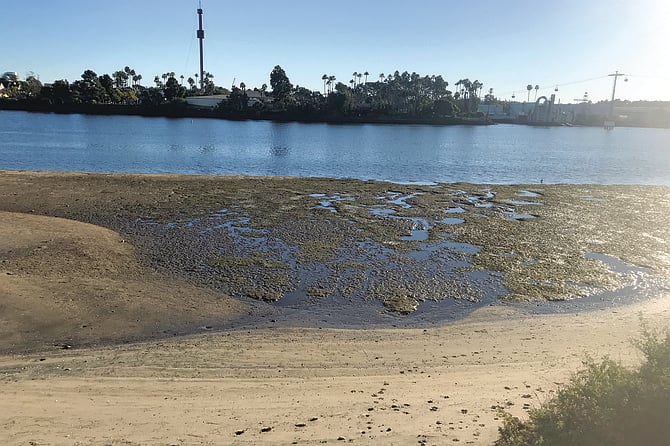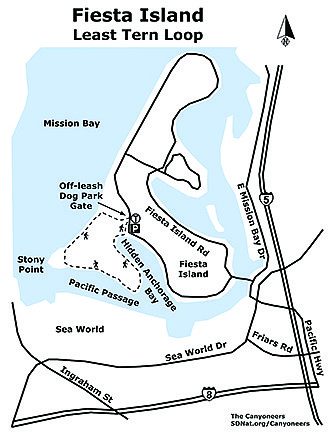 Facebook
Facebook
 X
X
 Instagram
Instagram
 TikTok
TikTok
 Youtube
Youtube

Not far from land, but safe from predators such as snakes, coyotes, raccoons, and domestic animals, the California least terns make their nests on Stony Point on Fiesta Island. This federally-listed endangered species primarily eats small fish, though they are also known to eat shrimp and other small aquatic invertebrates.
Fiesta Island itself is not a natural space; it was created by the accumulated sand dredged from False Bay when “Mission Bay” was created in the 1940s. The original marshland was fed by the San Diego River, which subsequently became confined by levees as the area was developed for recreation. Despite its man-made origins, the isolation of the island and surrounding food sources made it a good place for the terns to build their nests.
Start your hike by parking at the gate to the off-leash dog park. This looping trail will provide views of the bay from the island as you walk along Hidden Anchorage Bay and the Pacific Passage strait, which separates Fiesta Island from Sea World before reaching Stony Point and heading back. Keep an eye out for the native beach sun cup (Camissoniopsis cheiranthifolia), a generalist member of the evening primrose family that grows in sandy areas.
Hidden Anchorage Bay is a place where skiers train, but the muddy shoreline is great for viewing animal tracks. One of the most common mammals, domestic dogs, are often brought to this part of Fiesta Island to play and train. This makes the shoreline a good place to build tracking skills. Watch how a dog walks, leaps or bounds, and then check out the tracks that are left behind. The animal’s “foot prints” reveal not just the direction of travel but information about how they moved. These insights can be applied to other medium-bodied mammals, and the skills can be applied when looking for signs of the birds and small mammals that have come through here.
As you come around the Pacific Passage, look for aquatic birds (like the terns) diving for fish. Closer to shore, watch for wading birds — like godwit, plover, and sandpipers — walking in the shallows. If you look to the center of the loop, you may find native bird species using the grassy areas. As you continue along the island edge, you will reach Stony Point, clearly marked as a California least tern habitat by a barrier fence with informative signs and community artwork. Outside of the breeding season, the gates to the outer area will be open and you can hike to take in views of the main habitat for these beautiful birds.
FIESTA ISLAND LEAST TERN LOOP
Stony Point provides viewing areas for California least terns

Driving directions (Mission Bay): Exit I-5 at Sea World Drive. Go west, turn right on E. Mission Bay Drive, and then left onto Fiesta Island. Take the cut-off and park at the Hidden Anchorage Bay at the Fiesta Island off-leash area. Hiking length: 1.6 miles out-and-back. Allow 1 hour. Difficulty: Easy, less than 50-foot elevation change. Pets allowed. Mission Bay Park has restrooms. Note: Least tern mating season April-September. Birds will be present in greater numbers, but key portions of the trail will be closed to avoid disturbing least tern nests. Binoculars recommended for bird watching.


Not far from land, but safe from predators such as snakes, coyotes, raccoons, and domestic animals, the California least terns make their nests on Stony Point on Fiesta Island. This federally-listed endangered species primarily eats small fish, though they are also known to eat shrimp and other small aquatic invertebrates.
Fiesta Island itself is not a natural space; it was created by the accumulated sand dredged from False Bay when “Mission Bay” was created in the 1940s. The original marshland was fed by the San Diego River, which subsequently became confined by levees as the area was developed for recreation. Despite its man-made origins, the isolation of the island and surrounding food sources made it a good place for the terns to build their nests.
Start your hike by parking at the gate to the off-leash dog park. This looping trail will provide views of the bay from the island as you walk along Hidden Anchorage Bay and the Pacific Passage strait, which separates Fiesta Island from Sea World before reaching Stony Point and heading back. Keep an eye out for the native beach sun cup (Camissoniopsis cheiranthifolia), a generalist member of the evening primrose family that grows in sandy areas.
Hidden Anchorage Bay is a place where skiers train, but the muddy shoreline is great for viewing animal tracks. One of the most common mammals, domestic dogs, are often brought to this part of Fiesta Island to play and train. This makes the shoreline a good place to build tracking skills. Watch how a dog walks, leaps or bounds, and then check out the tracks that are left behind. The animal’s “foot prints” reveal not just the direction of travel but information about how they moved. These insights can be applied to other medium-bodied mammals, and the skills can be applied when looking for signs of the birds and small mammals that have come through here.
As you come around the Pacific Passage, look for aquatic birds (like the terns) diving for fish. Closer to shore, watch for wading birds — like godwit, plover, and sandpipers — walking in the shallows. If you look to the center of the loop, you may find native bird species using the grassy areas. As you continue along the island edge, you will reach Stony Point, clearly marked as a California least tern habitat by a barrier fence with informative signs and community artwork. Outside of the breeding season, the gates to the outer area will be open and you can hike to take in views of the main habitat for these beautiful birds.
FIESTA ISLAND LEAST TERN LOOP
Stony Point provides viewing areas for California least terns

Driving directions (Mission Bay): Exit I-5 at Sea World Drive. Go west, turn right on E. Mission Bay Drive, and then left onto Fiesta Island. Take the cut-off and park at the Hidden Anchorage Bay at the Fiesta Island off-leash area. Hiking length: 1.6 miles out-and-back. Allow 1 hour. Difficulty: Easy, less than 50-foot elevation change. Pets allowed. Mission Bay Park has restrooms. Note: Least tern mating season April-September. Birds will be present in greater numbers, but key portions of the trail will be closed to avoid disturbing least tern nests. Binoculars recommended for bird watching.
Comments